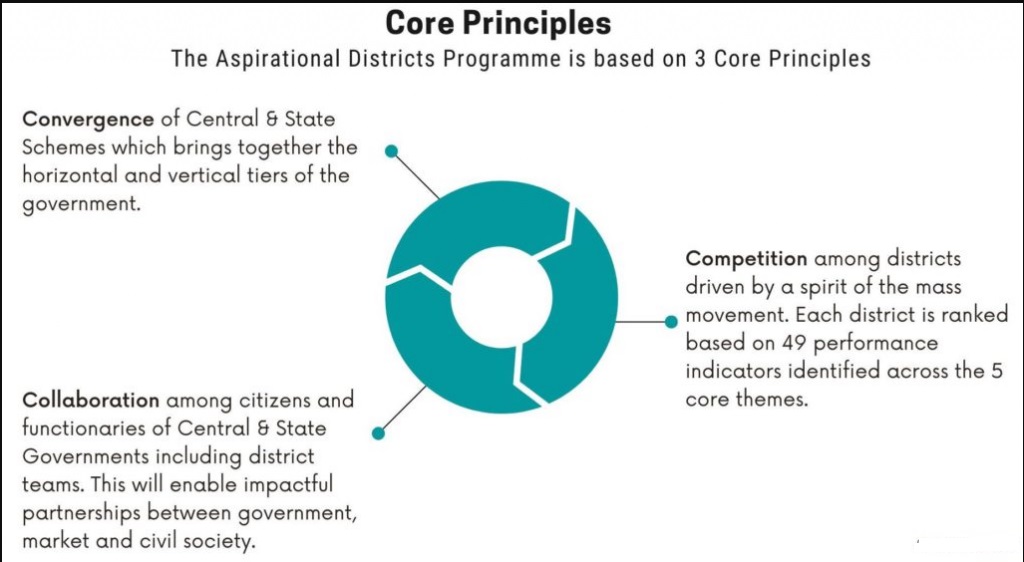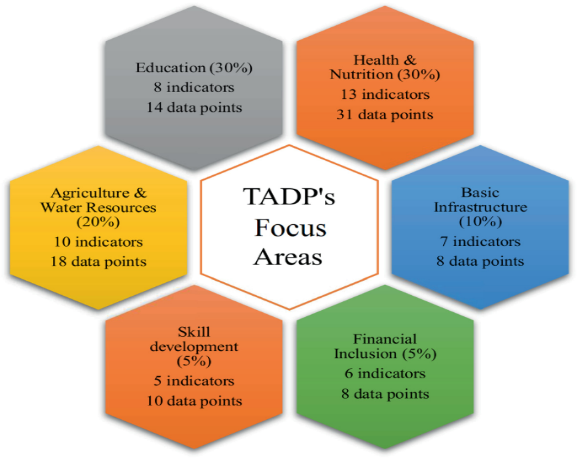Mains > Governance > Aspects of Good Governance > Governance
Syllabus
GS 2 > Governance > Aspects of Good Governance
REFERENCE NEWS
TRANSFORMATION OF ASPIRATIONAL DISTRICTS PROGRAMME (TADP)
 |  |
Institutional Framework: NITI Aayog anchors the program at the central level while individual ministries have been responsible to drive progress in districts States are the main drivers of the program For each district, a central Prabhari officer has been nominated. He/she should possess the rank of joint secretary/additional secretary.
| Core Strategy of the Program: Work on the strength of each district. Make development a mass movement in these districts. Identify low-hanging fruits and the strength of each district which can act as a catalyst for development. Measure progress and rank districts to spur a sense of competition.
|
The delta ranking of the Aspirational Districts combines the innovative use of data with pragmatic administration. The programme ranks districts based on the improvement achieved month-on-month through the Champions of Change dashboard (An online Dashboard).
SIGNIFICANCE OF TADP:
Decentralization of Development: TADP promotes local experimentation and solutions, tailored to the unique needs of each district. It recognizes the diverse ground realities, encouraging development strategies that are adapted to local contexts.
Deepens Cooperative Federalism: By involving state governments and Union Ministries, with NITI Aayog as the coordinating body, TADP fosters collaboration between different government levels. This partnership enhances the spirit of cooperative federalism in India.
Ensures Competitive Federalism: The program introduces a competitive element, ranking districts based on improvements in specific areas. This approach motivates districts to focus on tangible progress.
Encourages Private Participation: TADP opens doors for engagement with private and civil society sectors, leveraging corporate social responsibility. This inclusion brings in fresh ideas and additional resources, amplifying the program's impact.
A Decisive Shift in Governance Paradigm: TADP represents a reimagining of governance, learning from past failures. It focuses on efficiently reaching those in need with a more effective governance model.
Use of Smart Data: Emphasizing real-time, high-quality data collection, the program ensures that policy decisions are well-informed and responsive to current needs.
ACHIEVEMENTS OF TADP:
ISSUES ASSOCIATED WITH THE PROGRAM
1.Inadequate Coverage: Although the program is highly inclusive in nature, it fails to capture crucial variables like environment and gender.
2. Imbalance in implementation: Most districts channelised their efforts focused on health and nutrition, education, and agriculture and water resources. They paid less emphasis on the sectors of Skill Development and Financial Inclusion.
3. Budgetary Constraints: ADP is affected by the issue pertaining to insufficient budgetary resources. This sustains the lack of human resources and dearth of technical capacities at the district and block level.
4. Issues in Coordination: NITI Aayog plays a mentoring role in 27 districts in eight states. 12 Central Government Ministries have similarly adopted the remaining districts. Implementation involving multiple ministries leads to a lack of coordination.
5. Shortcomings of Delta Ranking: It is largely focused on assessing quantity (that is, coverage of access) rather than quality. For ex- Timely delivery of textbooks in schools is part of the ranking index, however very less weightage is given to the quality of education rendered in these districts.
WAY FORWARD:
1.Formulate strategies for saturation of indicators- Special focus is required in sectors like health, nutrition and education to recover lost ground due to the COVID-19 pandemic. Ex: Kerala model of Development
2. Strengthen governance mechanisms- Analysis has shown that districts perform better when the tenure of key officials like the District Magistrate, Chief Medical Officer, District Agriculture Officers etc. are stable. It is crucial that vacancies for these key positions are regularly filled and stability is provided by the state authorities.
3. Extension of ADP template- Extension of the ADP template to under-developed blocks and districts which are lagging behind in social indicators.
4. Addition of sectors- The first UNDP appraisal of the Aspirational Districts Programme has recommended a realignment of sectors under the program by addition of topics such as environment and gender. Ex: The Nordic countries' approach to gender equality, involving comprehensive policies and social norms, can serve as a model for integrating gender aspects into ADP.
The success of the ADP has been testified by national as well as international agencies. It is a flagship initiative for improving the lives of citizens residing in most backward regions of the country. The need of the hour demands overcoming its challenges and realizing the vision of ‘SABKA SAATH, SABKA VIKAS’ for ensuring inclusive development.
PRACTICE QUESTION
Q. ‘Aspirational Districts Program (ADP) is considered as a radical step because the exercise envisages a serious re-imagination of government and governance, and deepens cooperative federalism’. Discuss. (15M,250W)